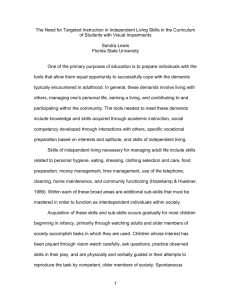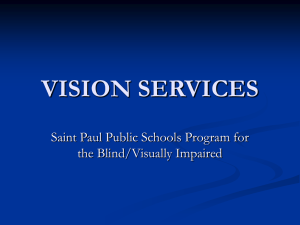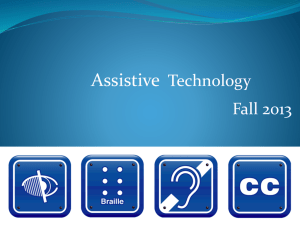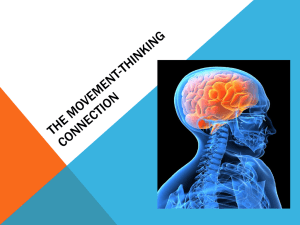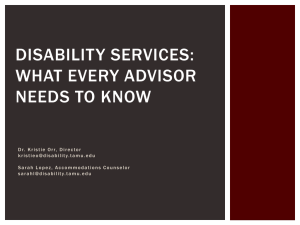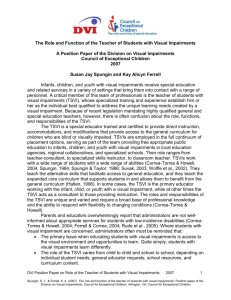104
advertisement
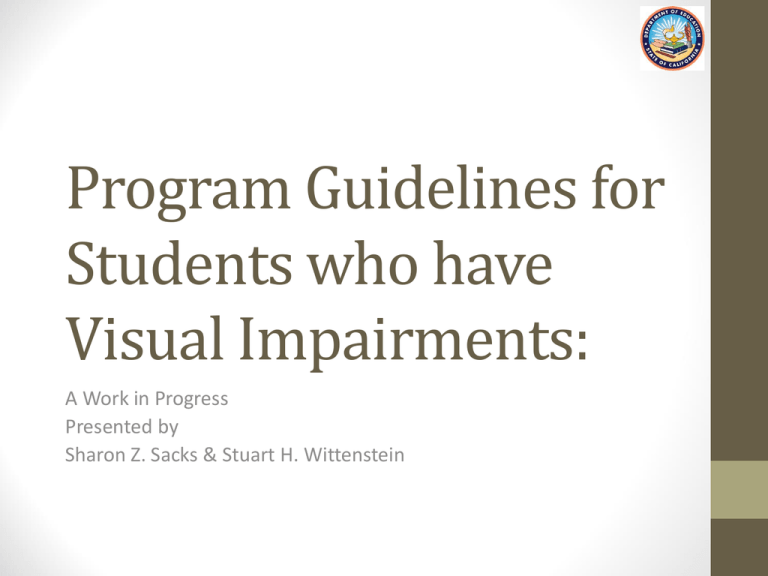
Program Guidelines for Students who have Visual Impairments: A Work in Progress Presented by Sharon Z. Sacks & Stuart H. Wittenstein Revision Process • In 2010 two groups of stakeholders met to provide feedback regarding revisions to the Program Guidelines. • Additional feedback was elicited at several professional & consumer conferences. • Limited revisions were made in 2011. • In April 2013 a contract was developed between CDE & CSB to coordinate & revise the Program Guidelines. Revision Process • A work plan was developed & two workgroups were selected to provide feedback & assist with project development. • Each group of stakeholders met, provided feedback, & assisted in writing tasks. • Sacks & Wittenstein worked with the writing teams, edited drafts, and worked to create a final draft that was submitted to CDE in December 2013. Members of Program Guidelines Task Force • Northern California • • • • • • • • • • • • • Amanda Lueck, Ph.D Sunggye Hong, Ph.D Sandra Rosen, Ph.D. Maureen Reardon, J.D. Lizbeth Barclay, M.A. Angela Martyn, M.A Yue-Ting Siu, M.A. Maurice Belote, M.A. Julie Bernas Pierce, M.A. Mary Willows, M.A. (NFBC) Jeff Thom, J.D. (CCB) Susan Mossman, M.A. Mary Beth Phillips, Ph.D. (Parent) • Southern California • • • • • • • • • Cheryl Hannan, Ph.D. Diane Fazzi, Ph.D. Robyn Herrara, M.A. Jennifer Cmar, M.A. Jane Vogel, M.A. Peggy Campbell, M.A. Nic Frank, M.A. Parisa (Parent) Nikki Blackburn, M.A. • Gina Mitchell, M.A. Program Guidelines Structure • Introduction • Chapter 1: Identifying & Assessing Unique Educational Needs • Chapter 2: The Core Curriculum & the Expanded Core Curriculum for Students with Visual Impairments • Chapter 3: Planning & Providing Instruction & Services • Chapter 4: Organizing & Supporting Instruction & Services Appendices • Appendix A: Self-Review Guide • Appendix B: Assessing Vision/Low Vision • Appendix C: Determining the Appropriate Learning Medium • Appendix D: California School for the Blind • Appendix E: Specialized Books, Materials, & Equipment • Appendix F: Legal Requirements • Appendix G: Resources for Technical Assistance • Appendix H: The Early Start Program • Appendix I: A Brief Overview of Cerebral Visual Impairment (CVI) Introduction • Provides a rational for updating the Program Guidelines • Provides a description of the process for revising the Program Guidelines • Describes the purpose of the Program Guidelines • Clarify process for identification & assessment • Provide information to improve program quality • Provide criteria for program self-review & monitoring Introduction Continued • Scope of the Program Guidelines • • • • • Focus on the unique educational needs Focus on integration of CCCS & ECC Focus on development of ECC content areas Focus on planning, service delivery, & quality instruction Focus on diverse learners: EL, students with additional disabilities • Use of the Guidelines • Assists families & professional in providing effective ways to meet the unique educational needs of students with visual impairments • Serves as a tool to improve the effectiveness of programs by maximizing resources • Provides references & resources for technical assistance & support Chapter One Identification & Assessment • Definition of Visual Impairment • Functionally blind students • Low vision student • Definition of neurological visual impairment-CVI • Students who are functionally blind or who have low vision, and may also have visual perceptual or visual motor dysfunction are eligible for visual impairment services. Who is not Eligible for VI Services? • Student who exhibit visual perceptual or visual motor dysfunction disabilities not related to a visual impairment. • Student who have diagnosed learning disabilities that include visual perceptual or visual motor disabilities. Identification Process • Coordination with vision screening programs • In-service straining for the educational staff & families on identifying behaviors that may indicate a visual impairment • Coordinate with local eye specialists • Coordination with Early Start programs Factors Affecting Identification • Age of onset-congenital versus acquired • Impact of additional disabilities & visual impairments • Time of identification-preschool, elementary level, secondary level • Nature of the visual impairment • Socio-economic status • English Language Learners Assessment of Students with Visual Impairments • • • • • Vision Report-Eye Care Specialist Functional Vision Assessment-TVI/O&M Learning Media Assessment-TVI Assessing the Common Core-TVI & classroom teacher Assessing the Expanded Core Curriculum-TVI & O&M specialist Functional Vision Assessment • Provides information about the nature & extent of the visual impairment • Determines what the student sees in a variety of settings • Evaluates how the visual impairment might adversely affect functioning in educational settings • Evaluates a student’s ability to move efficiently & safely across environments Functional Vision Assessment • Provides information to assist in the determination of learning media • Provides information about vision-related needs including interventions & modifications • Provides information about the need for O&M • Provides information for the family to seek further evaluation with an eye care specialist • Provide information for the educational team to coordinate services Learning Media Assessment • Observation of a student’s use of sensory channels in a variety of environments • Observation of student’s readiness for reading activities: ability to attend, conceptual understanding, developmentally appropriate language, & interest in books • Factors to determine learning medium: • Student’s level of visual fatigue • Student’s reading speed & comprehension level • Student’s auditory perception & listening skills Assessing the Common Core • TVIs need to team with general education teachers in the assessment of reading, language arts, mathematics, and other core content areas • TVIs need to assist with providing materials or modifying materials to assist the classroom teacher • TVIs need to provide direct instruction in abacus, assistive technology, & listening skills to support acquisition of the core curriculum Assessment of the Expanded Core Curriculum • Compensatory-TVI • Concept development • Braille & communication skills • Listening Skills • Study & organization skills • Orientation & Mobility-O&M specialist • Social Interaction Skills-TVI • Independent Living skills-TVI & O&M Specialist • Recreation & Leisure Skills-TVI & O&M Specialist • Career Education-TVI • Use of Assistive Technology-TVI • Sensory Efficiency Skills-TVI • Self-Determination-TVI Assessment Personnel • Assessment must be administered by qualified personnel who understand the unique educational needs of students with visual impairments. • Collaboration with the teacher of students with visual impairments must precede assessment to ensure that assessments are administered in an appropriate manner. Chapter Two The Common Core & the Expanded Core Curriculum • Students with visual Impairments require instruction in the Common Core & Expanded Core Curriculum. • Why the Expanded Core Curriculum? • Students require skills to access the core curriculum • Students require support to learn concepts & skills that are learned through observation by sighted peers • Students require hands on instruction to make sense of abstract concepts & the world around them • Students require instruction that promotes problem solving & opportunities to engage in real life experiences The Relationship Between the CCC & the ECC • TVIs & O&M specialists are not responsible for teaching common core subjects. • TVIs & O&M specialists are responsible for adapting, modifying, & preparing materials so that students can access the core curriculum. • TVIs & O&M specialists can integrate the common core when working with students on the ECC. Examples of CCC & ECC Integrated • Teaching Braille while working on literacy skills • Teaching a student to use a magnification device while teaching reading • Teaching a student to create a PowerPoint while teaching assistive technology • Teaching sharing & group conversation skills while working on a group project • Teaching math skills while teaching a student to use a budgeting app. Areas of the Expanded Core Curriculum Compensatory Skills • • • • • Concept Development Braille & Communication Skills Listening Skills Study & Organizational Skills Accessing the General Education Curriculum Orientation & Mobility • • • • • • • Sensory Motor Skills Spatial & Positional Concepts Body Image & Concepts Orientation to Indoor Environments Human Guide & Safety Techniques Instruction in the use of the long cane Instruction in the structure of neighborhoods & traffic patterns • Instruction in community travel • Use of public transportation Social Interaction Skills • • • • Specific social skills instruction Affective education Human Sexuality Psycho-Social Implications of Visual Impairment • Student’s understanding of visual impairment • Student’s ability to communicate visual needs to others Independent Living Skills • • • • • • • • • • Personal hygiene skills Dressing skills Care of clothing Housekeeping skills Preparation of food Eating skills Money management Telecommunication skills Written communication skills Time management Recreation & Leisure • • • • • • • Realizing that there are many options Learning to play indoor & outdoor games Developing hobbies Learning about different spectator activities Participating in a variety of recreational activities Knowledge of sports adaptations Knowledge of sports & activities in one’s community Career Education • • • • • • • • • Knowledge of one’s strengths & limitations Understands the concept of work Participates in chores at home & jobs at school Understands work ethic & demonstrates appropriate work behaviors Has observed a variety of jobs Understands the concept of work for pay Has a variety of volunteer experiences Has participated in a variety of work experiences Has developed a personal statement or resume Use of Assistive Technology • • • • • • • • • • Knowledge of the computer & keyboarding Us of screen readers Use of video magnification software Use of Braille displays Use of Braille note-takers Accessing programs for text reading & editing Non-visual use of touch screen devices Learning to use the internet & email Learning to use accessible GPS programs Learning to use scanners, & OCR devices Sensory Efficiency • Use of optical devices • Use of hearing aids • Use of assistive communication devices • Identify & discriminate textures & objects tactually • Use auditory skills to identify, discriminate, & track sound sources. • Use kinesthetic & proprioceptive sources • Identify, discriminate, * ise p;factpru semses/ Self-Determination • Understanding visual impairment & requesting accommodations • Being able to make choices • Develop ability to consider multiple options & anticipate consequences • Develop effective communication skills • Ability to set goals & monitor progress • Understanding one’s strengths & limitations • Understanding the concept of dependence, independence, & interdependence Chapter Three Planning & Providing Instruction & Services • Quality assessment drives the development of the IFSP, IEP, & ITP. • Specialized instruction should be provided by qualified personnel • Specialized books, material, & equipment should be provided to insure positive educational outcomes • A range of placement options should be discussed annually • Specialized curriculum & implementation strategies should be designed to insure success in the least restrictive environment Providing Instruction • Compensatory Skills • • • • • • • • • Braille reading & writing Use of low vision devices for reading & writing Slate & stylus for writing Listening skills Abacus & talking calculator for mathematical calculation Study skills Organizational skills Reading charts & graphs Use of specialized equipment to access literacy Special Considerations for Students with Additional Disabilities • Compensatory • Classroom modification to maximize the use of vision • Presentation of materials with respect to size, font, color, contract, & crowding • Presentation of pictures & photographs • Modify the classroom environment to maximize independence • Provide equipment & materials to access the general education curriculum • Provide strategies for labeling & using communication devices • Provide information about a student’s learning style Providing Instruction • Orientation & mobility • Must be implemented by a certified O&M specialist • • • • • • • • Environmental & spatial concepts Orientation techniques Self-protection skills Adaptive visual & non-visual mobility techniques Use of sensory input & residual vision for travel Daily living skills related to travel Knowing when & how to ask for assistance for travel Route planning & community travel including public transit Instruction in Social Interaction Skills • Students with visual impairments require assistance & support in developing social skills. These students do not acquire social abilities through incidental learning. They require instruction in the following areas: • Learning a repertoire of socially accepted behaviors for a variety of social situations • Learning play & social interaction skills • Learning social communication skills • Learning problem solving & perspective-taking Instruction in Social Interaction Skills • Affective education • Development of a positive self-concept • Development of realistic expectations • Human sexuality • Development of concepts with respect to self & others • Knowledge of public & private behavior • Knowledge of personal safety • Psycho-social implications of visual Impairment • Understanding of visual impairment • Understanding of strengths & limitations Instruction in Independent Living Skills • Instruction in Self-Help Skills • Personal hygiene, dressing, eating skills • Instruction in Home Management • Cooking, cleaning, clothing care, home maintenance • Instruction in Personal Management • Time management, money management, personal communication Instruction in Recreation & Leisure Skills • • • • Instruction in sports & athletic activities Instruction in games, board games, & other activities Instruction in physical fitness & aerobic activities Introduction to a wide range of hobbies & activities available in the community Instruction in Career Education • Career Awareness: Introduction to work, developing chores & responsibilities, awareness of jobs in the community • Career Exploration: Job shadowing, exposure to a range of jobs & job skills needed, • Career Preparation: Career assessment, work experience (volunteer & paid), demonstration of a range of work behaviors • Career Participation: Job placement, understanding of adaptations needed, work for pay Instruction in the Use of Assistive Technology • Evaluation & assessment determine what technology will be taught. • Students need a full range of technology experiences including use of computers, software program, access to the internet, access to social media, use of smart phones & tablets • Instruction should be integrated into the student’s curriculum. Instruction in Sensory Efficiency • • • • • Use of optical devices Tactile Input Auditory Input & Listening Skills Olfactory Input Proprioceptive Input & skill development Instruction in SelfDetermination • Areas of Instruction • • • • Self-awareness Choice making Self-advocacy Problem solving Specialized Books, Materials, & Equipment • Determination of what books, materials, & equipment needed for instruction is determined through the IFSP/IEP/ITP • Sufficient time must be allocated to purchase & transcribe books & materials in a timely manner. • The Clearinghouse for Specialized Materials & Technology (CSMT) is responsible for procuring & distributing books, Materials, & equipment throughout the state. • CSMT is responsible for the implementation of NIMAC which is based on the National Instructional Materials & Accessibility Standard (NIMAS) • Special funding for books, materials, & equipment is available for students with low incidence disabilities. Roles & Responsibilities of Key Personnel • • • • • • • • Teacher of Students with Visual Impairments Classroom Teacher Orientation & Mobility Specialist Aide/Paraprofessional Parent/guardian Student with a Visual Impairment Eye Specialist Physical Education or Adapted Physical Education Teacher • Occupational & Physical Therapist Roles & Responsibilities of Key Personnel Continued • • • • • • • • Speech/Language Pathologist School Nurse School Psychologist or Counselor/Social Worker Program Specialist Early Childhood Specialist Assistive Technology specialist Certified Braille Specialist (Transcriber) Reader Ancillary Staff in Residential programs • Dormitory personnel • Food service personnel • Health service personnel Chapter Four Organizing & Supporting Instruction & Services • Collaboration among professionals for instruction & services is essential. • Programs should provide specialized assessment. • Programs should provide a full range of program options. • Programs should provide personnel development & in-service training to staff who provide services to students with visual impairments. Administrative Responsibilities • Supervisor of Personnel • Knowledgeable about the unique educational needs of students with visual impairments • Knowledgeable about program options, funding sources, & legal requirements • Site Administrator • Knowledgeable about the unique educational & program needs of students with visual impairments • Assists in coordination of instruction & special services • Assists in providing & supporting the LRE • Provides facilities to meet the unique educational needs of students with visual impairments Placement in the Least Restrictive Environment • Focus on the assessed needs of the student • Consider each student’s needs for supplementary support & services • Assess the feasibility of implementing the student’s IEP • Consider a placement close to the student’s home • Annually discuss an array of placement options Program Options • • • • • • General education class without specialized services General education class with specialized services Special education class Special school for students with visual impairments Home services Hospital or public or private institutions Service Delivery Models • • • • • • Consultation Itinerant Services Resource Room for Students with Visual Impairments Special Day Class California School for the blind NPS options Class Size & Caseloads • Develop a process for establishing & monitoring class size & caseloads for TVI • Provide instruction based on the severity or intensity of student needs & age of student. • Severity of visual impairment • The consistency of instruction required to acquire essential skills • The need for additional time to learn new skills Additional Factors • Qualified staff available to perform specialized assessment • On going communication between school administrators & personnel serving students • Securing & preparing specialized materials, media, & equipment for students in a timely manner • Training teachers & paraprofessionals on effective teaching strategies for VI students • Providing adequate travel time for professional serving students with visual impairments • Consultation with eye care specialists & medical professionals • Consulting & assisting families • Professional development: attendance at conferences & workshops to enhance teaching skills Staff Development & Family Education • TVIs & O&M specialists should receive on-going training based on the development of a plan for training based on specific needs • Family education programs should include • Provide information about roles & responsibilities • Provide information about best practices in educating students with visual impairments • Provide information about resources & organizations for families of students with visual impairments Guidelines for Facilities • • • • • • • • • • Adequate lighting Adequate storage space for books & materials A separate area for listening activities Furniture & whiteboards with non-glare surfaces Sufficient outlets for technology A location on the site that is convenient for student access & mobility Adequate work space for students & for staff Office space for TVI, O&M specialist, & Braille transcriber Emergency procedures in place for safe student access Students’ transportation needs are adequately met
